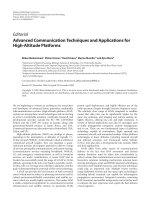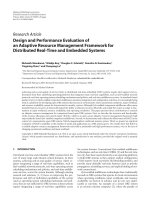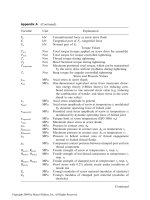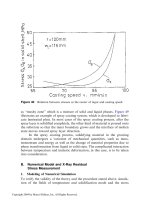Adaptive modeling and forecasting for high dimensional time series
Bạn đang xem bản rút gọn của tài liệu. Xem và tải ngay bản đầy đủ của tài liệu tại đây (3.32 MB, 182 trang )
ADAPTIVE MODELING AND
FORECASTING FOR HIGH-DIMENSIONAL
TIME SERIES
LI BO
(B.Sc.(Hons) National University of Singapore)
A THESIS SUBMITTED
FOR THE DEGREE OF DOCTOR OF PHILOSOPHY
DEPARTMENT OF STATISTICS AND APPLIED
PROBABILITY
NATIONAL UNIVERSITY OF SINGAPORE
2014iii
Thesis Supervisor
Ying CHEN Associate Professor; Department of Statistics and Applied Proba-
bility, National University of Singapore, Singapore, 117546, Singapore.
iv
Papers and Manuscript
Chen, Y. and Li, B. (2011). Forecasting Yield Curves in an Adaptive Framework,
Central European Journal of Economic Modeling and Econometrics, 3(4): 237–259.
Chen, Y., Li, B. and Niu, L. (2013). A Local Vector Autoregressive Framework and
its Applications to Multivariate Time Series Monitoring and Forecasting, Statistics
and Its Interface, 6(4):499–509.
Chen, Y. and Li, B. (2014). Adaptive Functional Autoregressive Modeling for
Stationary and Non-Stationary Functional Data, Submitted and under revision.
v
ACKNOWLEDGEMENTS
First and foremost, I am deeply grateful to my supervisor Professor Ying Chen
for her patience, guidance, encouragement and most importantly, her enlightening
ideas and valuable advice. I would like to thank Prof. Chen, not only for the
knowledge passed on but also for the passion she has demonstrated in doing re-
search, which have been tremendously helpful to me throughout these years. The
gratitude I owe not only arises from the formal academic supervision that I receive;
at the same time, it has also been due to Prof. Chen’s continuous support for all
aspects of my PhD study, in particular on possible research related opportunities
granted to me. Here, it is my honor to take this opportunity to extend my hearty
gratitude to my dear supervisor for all the memorable moments, both exciting and
challenging sometimes, that she has shared with me.
I would also like to thank Professor Wolfgang H¨ardle for generously sharing his
vi Acknowledgements
ideas and his invited visit to Center for Applied Statistics and Economics in Berlin
where the chances of exchanging research ideas and broadening my knowledge scale
have been granted to me. The alerting and enlightening talks and discussions with
Prof. H¨ardle have been rewarding and very helpful. Besides, my friends whom
I made the acquaintance of during the visit to Berlin have made the visit very
interesting and joyful. I would like to thank Weining Wang and Lining Yu for their
thoughtful reception and those interesting discussions we have shared together.
Meanwhile, it is my pleasure to thank Professor Yingcun Xia and Professor
Wei Liem Loh for many helpful conversations on both academic and non-academic
affairs. I would also like to extend my gratitude to Prof. Xia, Professor Jialiang
Li and Professor Kian Guan Lim from SMU for being my PhD thesis examiners.
Besides, I owe many thanks to my peer PhD students who have devoted their
time and attention for the discussions we have had together. Their suggestions are
of great help, which facilitates the accomplishment of the projects discussed in this
thesis. At the same time, thanks are due to the staff of the general office of our
Department for their constant support and help.
Last but not the least, I am much grateful for my husband Fan Gao for his
unconditional love and support, without whom this work would never be possible.
In addition, the encouragement and support from my parents and parents-in-law
have been of the utmost importance to me throughout the whole course of my
pursuit of PhD study. I would like to thank my family from the deep bottom of
my heart.
vii
Contents
Declaration ii
Thesis Supervisor iii
Papers and Manuscript iv
Acknowledgements v
Summary xi
List of Tables xiv
List of Figures xxii
Chapter 1 Introduction 1
1.1 Univariate non-stationary modeling . . . . . . . . . . . . . . . . . . 2
viii Contents
1.2 Multivariate non-stationary modeling . . . . . . . . . . . . . . . . . 6
1.2.1 VAR based models . . . . . . . . . . . . . . . . . . . . . . . 8
1.2.2 Factor models . . . . . . . . . . . . . . . . . . . . . . . . . . 12
1.3 Functional non-stationary modeling . . . . . . . . . . . . . . . . . . 15
1.4 Proposed methods and contributions . . . . . . . . . . . . . . . . . 20
Chapter 2 Factor model with FPCA 25
2.1 Smoothing of the data . . . . . . . . . . . . . . . . . . . . . . . . . 30
2.2 Method . . . . . . . . . . . . . . . . . . . . . . . . . . . . . . . . . 32
2.2.1 Extracting factors via FPCA . . . . . . . . . . . . . . . . . . 33
2.2.2 Fitting a LAR model to the factors . . . . . . . . . . . . . . 36
2.3 Simulation . . . . . . . . . . . . . . . . . . . . . . . . . . . . . . . . 39
2.4 Real Data Analysis . . . . . . . . . . . . . . . . . . . . . . . . . . . 43
Chapter 3 Multivariate model with LVAR 49
3.1 Method . . . . . . . . . . . . . . . . . . . . . . . . . . . . . . . . . 51
3.1.1 Adaptive vector autoregressive model . . . . . . . . . . . . . 51
3.1.2 Estimation under local homogeneity . . . . . . . . . . . . . . 52
3.1.3 Calibrate critical values . . . . . . . . . . . . . . . . . . . . 54
3.2 Simulation . . . . . . . . . . . . . . . . . . . . . . . . . . . . . . . . 58
3.2.1 Simulation design . . . . . . . . . . . . . . . . . . . . . . . . 59
3.2.2 Forecast accuracy . . . . . . . . . . . . . . . . . . . . . . . . 62
3.2.3 Robustness check . . . . . . . . . . . . . . . . . . . . . . . . 65
3.2.4 Model misspecification . . . . . . . . . . . . . . . . . . . . . 66
3.3 Real data analysis . . . . . . . . . . . . . . . . . . . . . . . . . . . . 68
Contents ix
Chapter 4 Functional model with AFAR 79
4.1 FAR modeling under stationarity . . . . . . . . . . . . . . . . . . . 82
4.1.1 Fourier basis expansion and sieve estimation . . . . . . . . . 85
4.1.2 Consistency results for sieve estimators . . . . . . . . . . . . 91
4.2 AFAR modeling under non-stationarity . . . . . . . . . . . . . . . . 94
4.2.1 Adaptive estimation procedure . . . . . . . . . . . . . . . . 97
4.2.2 Critical value calibration . . . . . . . . . . . . . . . . . . . . 99
4.2.3 Theoretical properties for the adaptive estimator . . . . . . 103
4.3 Simulation study . . . . . . . . . . . . . . . . . . . . . . . . . . . . 107
4.3.1 Stationarity: finite sample estimation accuracy . . . . . . . . 108
4.3.2 Non-stationarity: Scenarios with regime shifts . . . . . . . . 110
4.3.3 Robustness Checking . . . . . . . . . . . . . . . . . . . . . . 114
4.4 Real Data Analysis . . . . . . . . . . . . . . . . . . . . . . . . . . . 116
Chapter 5 Conclusion and future work 129
Appendix 133
Bibliography 142
x Contents
xi
SUMMARY
With the fast advances in computing technologies, high-dimensional data have
widely emerged in various areas, such as economics, bioscience, engineering, etc. In
particular, when high-dimensional data sets are observed with the evolution of time,
multivariate and high-dimensional time series modeling naturally attract massive
research and empirical interest. However, high dimensionality poses numerous
challenges and problems to modeling and implementations, due to the curse of
dimensionality. With complex data features, we may encounter problems such as
difficulties of identifying statistical models, infeasibility of numerical solutions and
defective estimation results. Consequently, how to deal with these problems comes
to be an essential step when we model and forecast high-dimensional data series.
Simultaneously, the existence of non-stationarity is also an inevitable issue to
xii Summary
handle in order to achieve desirable estimation and forecasting performance. Non-
stationarity poses many challenges as well, not only for theoretical modeling but
also for real time monitoring and forecasting. For instance, non-stationary model-
ing of financial returns has been discussed to be favourable in Mikosch and St˘aric˘a
(1998) and St˘aric˘a and Granger (2005), among others. Under the explosion of a
volatile market where stationary models are mis-specified, it is necessary to adopt
non-stationary models to accurately capture the data dynamics. However, existing
literature on the non-stationary issue for high-dimensional time series modeling
is rather limited, compared to univariate cases. In this thesis, we are motivated
to develop methods and models to analyze and forecast multivariate and high-
dimensional time series under the existence of non-stationarity. The proposed
models include factor model approach, adaptive multivariate approach and func-
tional approach.
In the factor model approach, high dimensionality is reduced to a low-dimensional
framework by applying functional principal component analysis (FPCA), with sig-
nificant data information effectively preserved. A data-driven methodology is pro-
posed to automatically select an optimal stationary time interval such that the
accuracy of forecasting is improved, compared with a benchmark competitor. In
the multivariate and functional approaches, the adaptive framework of a local uni-
variate model is extended to both multivariate and functional domains respectively.
In each of the two approaches, a simple underlying model structure is studied under
the adaptive framework, which maintains the modeling parameter space at a rea-
sonably low-dimensional level. Especially, in the functional approach, a consistent
maximum likelihood (ML) estimator for functional autoregressive (FAR) model
with nonzero mean function is derived. Theoretical properties of the proposed
Summary xiii
adaptive estimate are also studied and proved in functional domain. Besides, with
time-varying parameters, the proposed adaptive models can be safely applied to
both stationary and non-stationary real world time series. Simulation study and
real data applications are conducted for each of the proposed models. Reasonable
and inspiring results are achieved in comparison with existing benchmark models.
xiv Summary
xv
List of Tables
Table 2.1 Simulation results. The average values of RMSE between
the fitted and actual (generated) interest rates are reported for the
two scenarios. Both the DNS and FPCA methods are used in each
scenario. The results with smaller errors are marked in bold to
highlight better accuracy. . . . . . . . . . . . . . . . . . . . . . . . . 44
xvi List of Tables
Table 2.2 RMSFE: The average values of the out-of-sample forecast
errors for the forecasting horizons h of 1-, 6- and 12-month ahead at
various maturities, τ, from 3 months to 10 years. The DNS model
and the FPCA-LAR (F-L) model are applied to U.S. Treasuries and
China Treasuries. The better performance of F-L model is marked
in bold. . . . . . . . . . . . . . . . . . . . . . . . . . . . . . . . . . 48
Table 3.1 Parameters in the simulation scenarios. HOM refers to the
homogeneous scenario; and RS refers to the regime-switching (struc-
tural change) scenario. In each of the RS scenarios, only the labeled
parameter is changed in Phase 2. The other parameters remain the
same as in the original set-up. . . . . . . . . . . . . . . . . . . . . . 60
List of Tables xvii
Table 3.2 Forecast accuracy. The rolling window adopts one of the
predetermined window lengths of k × M, where k = 1, ··· , 19 and
M = 6, throughout the whole sample. The adaptive technique
adopts a selected time-varying window length among the choices
of the interval sets at each point of time. For the performance
of the rolling windows, only the best and worst results with the
related window choices are reported. We also report the number of
wins of the adaptive technique compared to the 19 rolling window
estimation alternatives. . . . . . . . . . . . . . . . . . . . . . . . . . 63
Table 3.3 Robustness testing (scenario RS-A): RMSE values. We com-
pare the default case of M = 6, K = 19 and Θ
∗
= Θ
0
to several
cases of alternative hyperparameters of M = 3 or 12, K = 10 or 30
and misspecified parameter Θ
∗
in the critical value calibration.
∗1
The first forecast is at time index 188 (instead of 122 as for others)
in order to correspond to the longest possible interval length.
∗2
An artificial VAR coefficient matrix is used to guarantee the ex-
istence of local homogeneity after being multiplied by 120% in the
mis12 scenario.
. . . . . . . . . . . . . . . . . . . . . . . . . . . . . . . . . . . . . . 67
xviii List of Tables
Table 3.4 Model misspecification with the true data generating process
of LVAR(5). In the table, p = 1 and p = 5 refer to the misspecified
and correct lag orders, respectively. Only the best and worst results
of all the rolling window approaches (with the corresponding window
sizes) are reported. The last two columns contain the LVAR results
and the number of cases where LVAR is better than the rolling
window approaches in terms of RMSE values. . . . . . . . . . . . . 69
Table 3.5 RMSE values of the iterative forecasts for NS factors NS1,
NS2 and NS3. Three types of models are employed: the LVAR
model with a time-dependent interval of local homogeneity, a VAR
rolling model with window sizes of 60 months and 120 months, and
a recursive VAR model. . . . . . . . . . . . . . . . . . . . . . . . . . 76
Table 3.6 RMSE values of the iterative forecasts for yields at 3-month,
12-month, 36-month, 60-month and 120-month maturities. Three
types of models are employed: the LVAR model with a time-dependent
interval of local homogeneity, the VAR rolling model with window
sizes of 60 months and 120 months, and the recursive VAR model. . 77
List of Tables xix
Table 4.1 Finite sample estimation accuracy for scenario HOM. The
misspecified estimation with AFAR modeling is compared with the
true data generating process (DGP) of FAR modeling. . . . . . . . 121
Table 4.2 RS scenario: estimation of the parameters when there is a
sudden change for one of the parameters. Each row reports the
estimation results for the changed parameter only. The second to the
fifth columns contain the average values of the estimated parameters,
RMSE, MAD of the estimators and the largest deviation (LD) of the
estimates for those unchanged parameters from the HOM scenario
for phase 2. The last five columns contain results for phase 3. . . . 122
Table 4.3 Detection delay for RS scenarios: the first four columns con-
tain the average number of steps needed to reach 50%, 60%, 70% and
80% of the true values for phase 2. The last four columns contain
results for phase 3. . . . . . . . . . . . . . . . . . . . . . . . . . . . 123
xx List of Tables
Table 4.4 RS-c
1
scenario with upward large, upward small, downward
large and downward small jumps: Each row reports the estimation
results for the changed parameter only. The second to the fifth
columns contain the average values of the estimated parameters,
RMSE, MAD of the estimators and the largest deviation (LD) of the
estimates for those unchanged parameters from the HOM scenario
for phase 2. The last five columns contain results for phase 3. . . . 124
Table 4.5 Detection delay for RS-c
1
scenario with upward large, upward
small, downward large and downward small changes. The first four
columns contain the average number of steps needed to reach 50%,
60%, 70% and 80% of the true values for phase 2. The last four
columns contain results for phase 3. . . . . . . . . . . . . . . . . . . 125
Table 4.6 Robustness checking in RS-c
1
scenario: “mis0.8” and “mis1.2”,
“mis0.7” and “mis1.3” , “mis0.6” and “mis1.4” , “mis0.5” and “mis1.5”
refer to the misspecified cases where the underlying parameter is bi-
ased with ±20%, ±30%, ±40% and ±50% deviation. “S = 6” and
“S = 12” refer to the cases with fewer and more interval candi-
dates. “sparse” and “intensive” refer to a sparse set with 5 interval
candidates and an intensive set with 12 candidates. Four cases for
different α values are also studied. . . . . . . . . . . . . . . . . . . . 126
List of Tables xxi
Table 4.7 1-day ahead forecasts: RMSE of the out-of-sample forecasts
using the FAR models, VAR(1) model and univariate models. In
particular, the AFAR forecasts are compared with the FAR updated
with rolling window technique of fixed window size 150 and 300,
VAR(1), ARX, AR(1) and seasonal AR models. . . . . . . . . . . . 127
Table 4.8 14-day ahead forecasts: RMSE of the out-of-sample forecasts
using the FAR models, VAR(1) model and univariate models. In
particular, the AFAR forecasts are compared with the FAR updated
with rolling window technique of fixed window size 150 and 300,
VAR(1), ARX, AR(1) and seasonal AR models. . . . . . . . . . . . 128
xxii List of Tables
xxiii
List of Figures
Figure 1.1.1 U.S. interest rates at maturity 3-month (left) and sample
ACF plot (right) of the data. Data: monthly yield curves of U.S.
Treasuries from January 1983 to December 2010. . . . . . . . . . . 3
xxiv List of Figures
Figure 1.2.1 Sample autocorrelations of the log-prices at 9am and sample
cross-correlations between 8am and 9am are displayed. Raw elec-
tricity log-prices are plotted at the top panel. The measures are
computed using the whole sample from 5 July 1999 to 11 June 2000
in the middle panel. The bottom shows the respective sample au-
tocorrelations and cross-correlations using a subsample from 5 July
1999 to 23 August 1999 . . . . . . . . . . . . . . . . . . . . . . . . 7
Figure 1.3.1 Left: Log-prices of the California electricity market for 24
hours a day, 7 days a week from 5 July 1999 to 11 June 2000. Right:
Smoothed log-price curves of the California electricity market. . . . 16
Figure 2.0.1 The empirical factor loadings of the China yield curves (right)
and the NS exponential loadings (left). In the NS framework: the
level loading is 1; the slope loading is (1 − e
−λ
t
τ
)/λ
t
τ and the cur-
vature loading is (1 − e
−λ
t
τ
)/λ
t
τ − e
−λ
t
τ
, with λ
t
= 0.0609 and τ
denoting the time to maturities. Data: monthly yield curves of
China Treasuries from March 2003 to October 2011, Datastream. . 27
List of Figures xxv
Figure 2.0.2 The level factor based on the Nelson-Siegel exponential basis
(left) and its sample ACF plot (right). Data: monthly yield curves
of U.S. Treasuries from January 1985 to December 2000, see also
Diebold and Li (2006). . . . . . . . . . . . . . . . . . . . . . . . . . 29
Figure 2.1.1 The estimated yield curves for U.S. Treasuries (left) and
China Treasuries (right) via B-splines. . . . . . . . . . . . . . . . . 32
Figure 2.2.1 The sample covariance surfaces of the yield curves of U.S.
Treasuries from January 1985 to December 2000 (left) and of China
Treasuries from Mar 2003 to Oct 2011 (right). . . . . . . . . . . . . 34
Figure 2.3.1 One realization of the FPCA factor loadings for both simu-
lation scenarios. In the DNS or U.S. scenario, the resulting factor
loadings well represent the underlying NS exponential curves (left).
In the FPCA or China scenario, the resulting factor loadings are
good proxies of the underlying curves, too (right). . . . . . . . . . . 42
Figure 2.4.1 Out-of-sample forecasts. The actual discrete interest rates
(dotted), the DNS forecast (right) and the FPCA-LAR forecast
(left) for 1-, 6- and 12-month ahead horizons on dates July 1994
for U.S. market and April 2010 for China market. . . . . . . . . . 46









